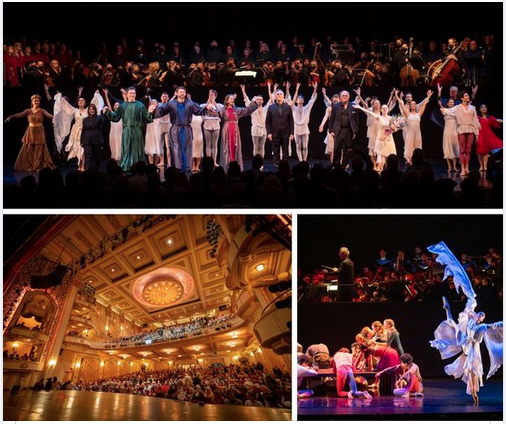SANTA BARBARA SYMPHONY: CARMINA BURANA REVIEW OCTOBER 15, 2022
Read my review for VOICE Magazine of the season opening concert on October 15, 2022:
Santa Barbara Symphony/Santa Barbara Choral Society/State Street Ballet/SBCC Quire of Voyces/Music Academy Sing! Children’s Chorus
Pavane, Bacchanale, Carmina Burana — what a party!
If success can be measured in smiles, last weekend’s pair of Granada Theatre concerts by the combined musical forces of the Santa Barbara Symphony, Santa Barbara Choral Society, State Street Ballet, SBCC Quire of Voyces, and Music Academy Sing! children’s chorus, was an ear-to-ear triumph. The massive collaborative effort represented metaphorically, a catharsis and joyful sunrise. With flourishes, banners, dancers, orchestra, and choruses large and small - a combined cast of just under two hundred - Santa Barbara’s performing arts organizations gathered again at last, to announce they are back in the game, the 2022-2023 season is on!
Packed houses on Saturday night and at Sunday afternoon’s matinee, sipped champagne in celebration of the Santa Barbara Symphony’s 70th birthday, while also raising a collective toast to the performing arts professionalism we enjoy year-round in this community. On the program, Gabriel Fauré’s Pavane in F-Sharp minor, Op. 50 (1887), with new choreography by State Street Ballet’s Co-Artistic Director and Resident Choreographer, William Soleau; a feisty entr’acte for the orchestra alone, Camille Saint-Saëns’ Bacchanale from his opera Samson and Delilah (1877); and to end each of the two concerts with a mighty spectacle, Carl Orff’s rowdy masterpiece, Carmina Burana (1936).
The last time a collaborative musical joy ride of this caliber blew the roof off the Granada Theatre was in 2015, the first successful joint presentation by Santa Barbara performing arts groups of Carl Orff’s deliciously naughty mega-cantata for dancers, choruses, orchestra, and soloists. Seven years later the venue is the same, professionalism and thrills a given, but important changes scenically, choreographically, and musically, have spruced up this second collaboration. The result is fresh to eyes and ears on several levels.
Tight performance standards and compelling energy marked the entire program Saturday night, charioted with vigor by Santa Barbara Symphony Music and Artistic Director Nir Kabaretti, who kept the pace and purpose of all three works on the program athletic, taut, and intellectually exciting. A stunning new cadre of young professional dancers at State Street Ballet made their debut as well, immediately dispelling any worries about the artistic bottom line, with precise yet fluid corps de ballet accuracy, with consistent finesse in execution.
The Santa Barbara Choral Society, SBCC Quire of Voyces and Music Academy Sing! Children’s Choir sounded particularly well-rehearsed and tight in ensemble balance, color, and intonation. Kudos, conductors Jo Anne Wasserman, Nathan Kreitzer, and Erin McKibben. Clean staging and lighting design also enhanced the look on stage in surprising and satisfying ways.
Choreographer William Soleau illuminated visually, two of the works on the program, creating elegant new choreography for Gabrielle Fauré’s Pavane in F-Sharp minor, Op. 50 (1887) a sublime movement reverie for an ensemble of six, while tweaking here and there, his original 2015 choreography for Carmina Burana, achieving a marvelously successful if subtle, transformation of the 2015 original.
Perhaps it was the lighting design of Sammy Jelinek, or some subtle changes in wardrobe by Nicole Thompson. Certainly, the confident and precise ensemble, solo, and duo dancing throughout the evening by State Street Ballet’s new gaggle of stunningly versatile artists contributed to the sense that the 2022 Carmina Burana was entirely fresh. Salutations, State Street Ballet principals Amara Galloway and Herñan Montenegro (The Couple), Marina Fliagina (Fortuna), and Leeza Domrachev (The Swan).
Vocal soloists for Carmina Burana, soprano Jana McIntyre, countertenor Randall Scotting, and baritone Valdis Jansons, made much of their often-perilous musical roles. Orff’s writing for these three is mercilessly virtuosic. Vocal resilience, fortitude, intelligent coloration, and high skill marked the performances by all three.
The Santa Barbara Symphony and all the participating choirs except the children’s choir, which did their bits on the dance stage, could be seen perched handsomely on a platform behind and above the on-stage dance area. A scrim just in front of the orchestra allowed for visual projections and other special lighting effects as needed, while also making slightly mysterious and intriguing, the visual illusion of an orchestra suspended in midair.
Conductor Nir Kabaretti, smack in the center of it all, commanded a ringside overview of the dance action going on below. Handy for the Fauré, Kabaretti’s elevated position and visibility was crucial during the massive and often tricky sections of Carmina Burana.
A bonus made particularly apparent during the orchestra’s elegantly cosmopolitan performance of the Bacchanale scene from Camille Saint-Saëns’ opera Samson and Dellilah (1877); being elevated, thus closer to the acoustic shell’s ceiling panels, the orchestral sound projecting into the hall seemed particularly clean, balanced, articulate, and detailed.
Daniel Kepl | Performing Arts Review







Pavane

Samson and Dellilah

Maestro Nir Kabaretti